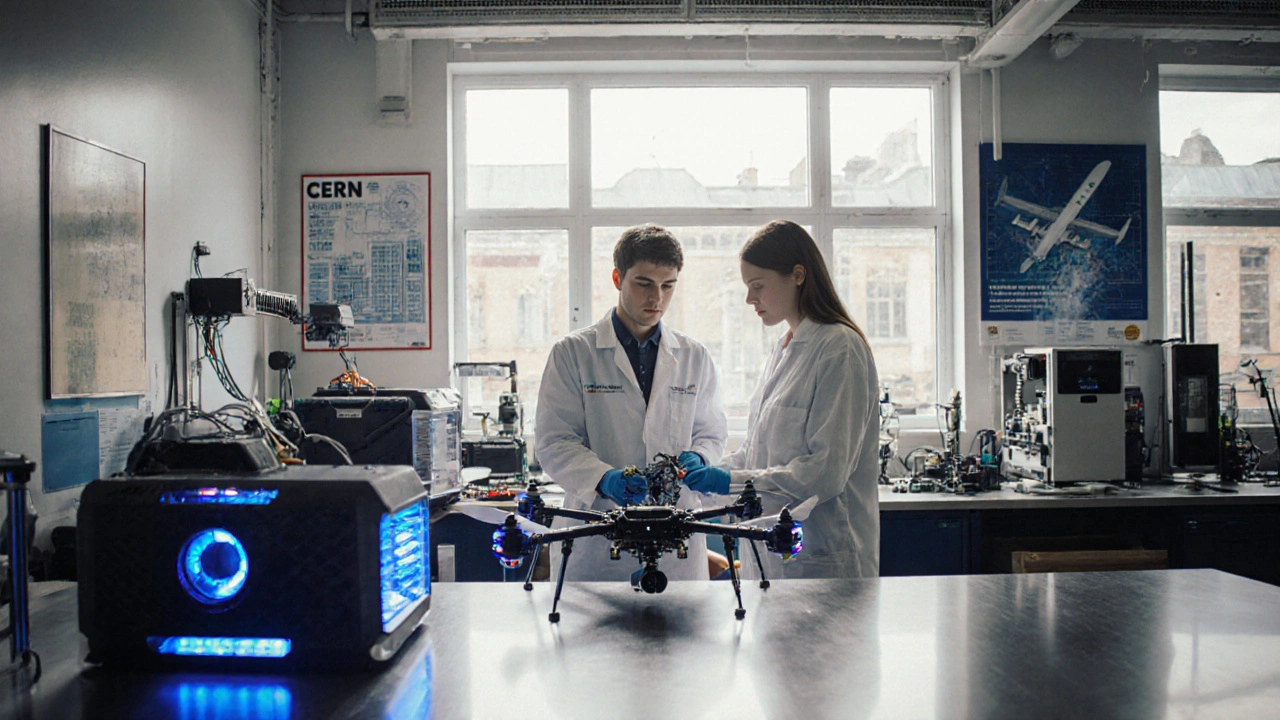Imperial College London isn’t just another university. It’s where future engineers build electric planes, where biologists crack open disease codes, and where students walk past Nobel laureates in the cafeteria. If you’re thinking about studying science or engineering here, you’re not just picking a school-you’re joining a machine that turns theory into real-world impact. But what’s it actually like to live and learn here? Let’s cut through the brochures and talk about the real stuff.
What You’ll Study: No Fluff, Just Hard Science
Imperial’s science and engineering programs are built for people who want to solve problems, not just memorize formulas. The engineering programs cover everything from aerospace to biomedical, with a heavy focus on hands-on design. In Year 1, you’ll likely build your own robot or prototype a wind turbine. By Year 3, you’re working with industry partners like Rolls-Royce or Siemens on live projects.
The science programs are equally intense. In chemistry, you’ll spend half your week in labs running reactions that could lead to new cancer drugs. In physics, you’ll use particle detectors that are part of CERN’s experiments. Biology students work with real patient data, not just textbook models. There’s no watered-down curriculum here-every module is designed to push you past what you thought you were capable of.
Most degrees are four years long (MEng, MSci), and the final year includes a major research project. These aren’t fake assignments-they’re often published in journals or turned into patents. One 2024 graduate developed a low-cost water filter that’s now being tested in rural Kenya.
Classrooms, Labs, and the Real-World Edge
Forget lecture halls where you’re just a number. Imperial’s teaching model is built around small-group work. Even in first-year classes, you’ll be in teams of 6-8 with a tutor who knows your name. Labs aren’t just demonstrations-they’re your main classroom. In the Department of Mechanical Engineering, students get 12 hours of lab time per week. That’s more than most universities offer in a whole semester.
The college owns its own research centers, like the White City Innovation Campus, where students prototype devices in real time. You might be designing a drone one day and testing a new MRI algorithm the next. The equipment isn’t outdated either-Imperial spent over £300 million upgrading labs between 2020 and 2024. You’ll use the same tools that top companies use: 3D metal printers, quantum computing simulators, and AI-driven material analysis systems.
Professors here aren’t just researchers-they’re founders, consultants, and patent holders. Many teach because they want to shape the next wave of innovators, not because they have to. It’s common to see a professor walk into class straight from a board meeting at a startup they co-founded.
Student Life: High Pressure, High Reward
Let’s be honest-Imperial is tough. The workload is heavier than at most UK universities. The average student spends 45-50 hours a week on coursework, labs, and study. Sleep isn’t a luxury; it’s a strategic resource. But it’s not all grind. The culture is built on collaboration, not competition.
Student societies are where the real magic happens. The Imperial Formula Student Team designs and races electric cars against 100+ global universities. The Biomedical Engineering Society runs hackathons with NHS doctors. There’s even a Space Society that launched a high-altitude balloon last year that captured footage from 30km up.
Most students live in halls on or near the South Kensington campus. Rent for a single room in university housing runs between £180-£240 per week. That’s steep, but you’re walking to class in 5 minutes. Off-campus options in Chelsea or Kensington are cheaper but cost you 30-45 minutes each way. Many students split rent in shared flats near Earl’s Court-just a 15-minute tube ride away.
Food on campus is decent but expensive. A full meal in the main canteen costs £8-£12. Most students cook in their flats. A weekly grocery run for two people averages £35-£50. There’s a large Tesco just outside the main gate, and a weekly farmers’ market on campus every Friday.

Connections That Matter
Imperial has one of the highest graduate employment rates in the UK-96% of science and engineering students are in work or further study within six months of graduating. Why? Because companies know Imperial grads can handle pressure.
Every year, over 200 companies recruit on campus. Google, Boeing, GlaxoSmithKline, and BP all have dedicated hiring pipelines. Internships aren’t optional-they’re built into the curriculum. Most students complete at least one paid internship during their degree, often abroad. One engineering student spent a summer in Singapore working on smart grid tech. Another did a research placement at MIT.
The alumni network is powerful. Graduates run tech startups, lead research labs, and sit on government science panels. You’ll meet them at career fairs, guest lectures, and even casual coffee chats organized by the student union.
What It Costs-And What You Get
UK students pay £9,250 per year for tuition. International students pay between £38,000 and £45,000, depending on the program. That’s a lot. But Imperial offers more scholarships than most UK universities. The President’s Scholarships cover full tuition plus £12,000 living support for top international applicants. There are also department-specific awards for women in engineering and students from underrepresented backgrounds.
Living costs in London are high, but Imperial helps you manage them. The student union runs a free bike repair shop, a food bank for students in need, and a £500 emergency grant fund. Many students use the free Oyster card discount for public transport. You can also get 50% off gym memberships at the college’s fitness center.
Compared to US universities with similar prestige, Imperial is cheaper. MIT or Stanford might cost $70,000 a year-Imperial’s international fees are about 30% lower. And you get three years of study instead of four. That’s a big saving.

Is This Right for You?
Imperial isn’t for everyone. If you want a relaxed campus with lots of parties and light coursework, look elsewhere. But if you want to be surrounded by people who talk about fusion energy over lunch, who stay up until 2 a.m. debugging code for a satellite project, and who leave here with a resume that opens doors from Tokyo to Toronto-then this is your place.
The biggest mistake students make? Underestimating the pace. The first term is brutal. You’ll feel overwhelmed. That’s normal. The key is to join a study group early, use the free tutoring center (it’s open 12 hours a day), and don’t be afraid to ask for help. The college has mental health support, academic advisors, and peer mentors-all free.
You won’t remember every equation you learned here. But you’ll remember the day your prototype worked. The day you presented your research to industry leaders. The day you realized you weren’t just learning science-you were helping shape it.
What’s the acceptance rate for science and engineering programs at Imperial College London?
The overall acceptance rate for undergraduate science and engineering programs is around 12-15%. For competitive courses like Aerospace Engineering or Biomedical Engineering, it’s closer to 8-10%. Most offers go to students with A*AA or higher at A-level (or equivalent), especially in Maths and Physics. Strong personal statements and relevant extracurriculars-like science fairs, coding projects, or internships-make a big difference.
Can international students work while studying at Imperial?
Yes. International students on a Student visa can work up to 20 hours per week during term time and full-time during holidays. Many find part-time roles on campus-lab assistants, library staff, or tech support. Off-campus jobs are common too, especially in tech startups near White City. The career service helps students find paid internships that count toward their degree.
How do Imperial’s engineering programs compare to those at UCL or King’s College?
Imperial focuses on applied science and engineering with strong industry links. UCL is broader, with more emphasis on theoretical research and interdisciplinary work. King’s is smaller and more focused on medical engineering. Imperial graduates are more likely to go into aerospace, energy, or tech startups. UCL grads often go into healthcare tech or urban innovation. King’s students tend to work in biomedical devices. Imperial’s labs are newer, its industry partnerships deeper, and its graduate salaries higher on average.
Are there any scholarships specifically for women in engineering at Imperial?
Yes. Imperial offers the Women in Engineering Scholarship, which covers full tuition and £10,000 living costs for up to 20 female students each year. There’s also the Imperial Women in STEM Bursary, which provides £5,000 annually for those from low-income backgrounds. Applications open in January and require a short essay and academic references.
What’s the average salary for Imperial engineering graduates?
According to the 2024 Graduate Outcomes Survey, the median starting salary for Imperial engineering graduates is £42,000. Aerospace engineers average £46,000, while data and AI engineers earn around £48,000. Graduates in biomedical engineering start at £39,000. These numbers are among the highest in the UK, and 85% of graduates report being satisfied with their career path within a year of finishing.
Next Steps: How to Prepare
If you’re serious about applying:
- Take the Further Maths A-level if possible-it’s strongly recommended for engineering.
- Build a small project: a robot, an app, a science experiment. Document it on GitHub or a blog.
- Reach out to current students through Imperial’s student ambassador program. They’ll tell you what’s really expected.
- Apply early. Deadlines are in January, but top applicants get interviewed in December.
- Don’t skip the personal statement. Tell them why you want to solve real problems, not just get a degree.
Imperial doesn’t want perfect students. It wants curious, stubborn, creative ones who aren’t afraid to fail-and then try again. If that sounds like you, you already belong here.
